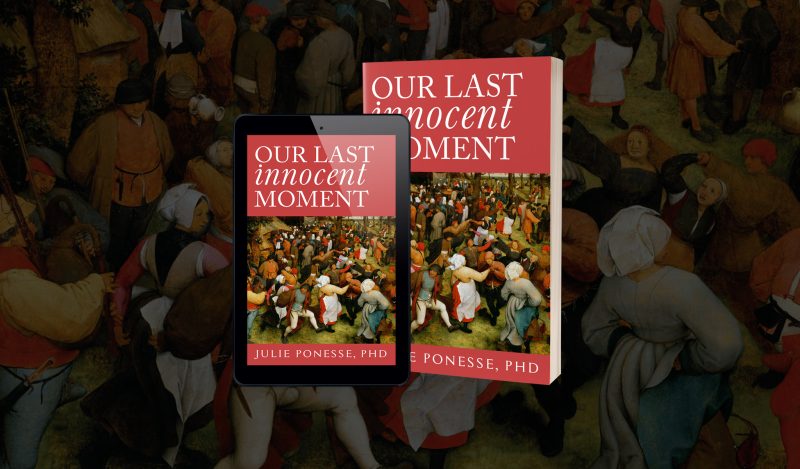At the beginning of the pandemic, I couldn’t wrap my mind around why so many people were acting in such irrational and self-destructive ways. I had to find a way to explain their behavior, even if just to myself. Despite being an infectious disease immunologist, this meant delving into human psychology. Fortunately, I found many illuminating sources and found the subject endlessly fascinating, which I believe is reflected in my book (especially Chapters 5 and 7). Earlier this year, I had a chance to discuss the psychology of the pandemic response (among other topics) with famed psychologist Jordan Peterson, which was definitely a highlight within a year of highlights.
The following is adapted from Chapter 5 of my book Fear of a Microbial Planet: How a Germophobic Safety Culture Makes Us Less Safe.
The Nocebo Effect
The gory imagery and vivid descriptions of symptoms and pathologies of infectious diseases depicted in my first-year medical school course can have an interesting effect on some medical students. I remember a similar effect in my undergraduate medical microbiology class:
Instructor: “And the onset of symptoms for this particularly nasty infection is characterized by a stiff neck and…”
Me: (Starts to rub neck).
This is known as the nocebo effect—where an expectation or suggestion of a symptom can cause it to appear or worsen.It’s the categorical opposite of the placebo effect, where the expectation of symptomatic improvement leads subjects to report that they have, in fact, improved, even in the absence of actual treatment.
In some cases, the development of symptoms that are directly a result of a person’s expectations are quite serious. One case study published in 2007 reported a man that overdosed on an experimental anti-depressant after an argument with his girlfriend, taking 29 of the pills he was given as part of the study. After being rushed to the hospital, he registered an extremely low blood pressure of 80/40 and an elevated heart rate of 110 beats/minute. Doctors and nurses pumped him full of saline and were able to raise his blood pressure somewhat, to 100/62.
But the doctor that really cured the patient was the one from the clinical trial, who arrived and told him that those antidepressant pills he overdosed on were actually placebos and didn’t contain any medicine. He was part of the control group! Within fifteen minutes, the man’s blood pressure and heart rate were normal.
Overdosing on a placebo didn’t kill the man, but simply thinking he was going to die resulted in profound physiological effects. This is true of both placebo and nocebo effects, where the analgesia-inducing β-endorphin release (in addition to dopamine) of the former is counteracted by cholecystokinin (CCK) of the latter.
In other words, both placebo and nocebo effects can be directly measured by neurochemical release and blocked by specific drugs that interfere with their action. A prime example of neurochemical release of the placebo effect is in Parkinson’s Disease patients, where placebo treatment can result in improvement in mobility.
By measuring endogenous dopamine by positron emission tomography (which measures the ability of a radioactive tracer to compete with binding to dopamine receptors), a landmark 2001 study showed that placebo treatment in Parkinson’s patients resulted in dopamine release in multiple areas of the brain. It’s not just the belief itself, but the chemical changes that result because of the expectation and desire that a treatment will cause an improvement (placebo) or a worsening of pain or disease symptoms (nocebo).
Unfortunately, the power of belief can result in some profound negative mental and physiological effects on individual and group levels. At the group level, the nocebo effect is particularly powerful in germophobes and otherwise normal people alike, and can increase quickly, just like transmission of a highly contagious virus.
Hysteria for the Masses
In Portugal in 2006, authorities had to deal with a troubling outbreak. Hundreds of teens had come down with a mysterious illness characterized by rashes, dizziness, and difficulty breathing. Yet there was no mass exposure to a chemical or infection with a virus that could explain the outbreak. The only common thread that investigators could pinpoint was a teen soap opera, named “Morangos com Acucar”, or “Strawberries with Sugar.” Just prior to the real outbreak, the show had dramatized a fictional one, where characters were infected with a serious illness caused by a mysterious virus.
However, in the real world, the students weren’t merely faking their symptoms to get out of final exams. They truly believed they were ill. Instead of a mysterious virus or an exposure to a toxic chemical, the students were suffering from mass psychogenic illness, or mass hysteria.
In 2018, on an Emirates Airlines flight from Dubai to New York, 100 passengers reported feeling ill after observing others with flu-like symptoms. As a result of the panic, the whole flight was quarantined after it touched down in New York. Even the presence of 90s rapper Vanilla Ice on the flight wasn’t enough to chill the panic. Investigators determined afterwards that only a few passengers were ill with seasonal flu or common colds. Everyone else instead suffered from mass hysteria.
Mass hysteria isn’t anything new, as examples of hysterical responses to outbreaks I’ve already discussed in the previous chapter qualify. From attacks on Jews during the plague to communities in thrall to vampire superstitions about TB victims, mass hysteria has played a role in many pandemic related events throughout history. The Salem Witch Trials, although possibly related to food contamination with psychedelic fungi instead of infectious disease, is one of the most famous examples.
Historically, places where large numbers of people were confined in tight spaces under stressful conditions were considered the most likely locations for outbreaks; convents, factories, and boarding schools are often at the center of such incidents. Throughout history, mass hysteria is overwhelmingly associated with groups of women or teen girls (about 99% of all incidents). In fact, “hysteria” is derived from the ancient Greek word “hystera”, which means “of the womb.”
The incidents usually begin with some inciting event, like the fictional outbreak on Strawberries with Sugar, but usually involves one individual reporting a mysterious occurrence and subsequent symptoms. Often unknown taste, foul odor, or fumes are blamed, or sometimes another individual with symptoms is believed to carry a contagious disease. Very quickly, multiple people appear affected, and this can spread for days and sometimes weeks, with several waves. However, further investigation yields no obvious cause.
Shortly after the terrorist attacks of September 11th, 2001, five letters containing anthrax spores were sent to senators and media outlets, killing five and causing infection in 17 others. As a result of the attacks, the threat of biological terrorism became highlighted on the front page of almost every newspaper, with repeated coverage on every major news program.
The fear and anxiety about the potential for release of unseen biological agents of mass destruction in the wider population provided a major source of fuel for outbreaks of mass hysteria. More than 2,000 false anthrax scares were reported in the United States after the initial attacks, people were on edge and looking for evidence of bioterrorism everywhere. When Bruce Ivins, an anthrax researcher at USAMRIID, committed suicide under suspicious circumstances, the FBI reported that they believed he was the sole perpetrator of the anthrax-laced letter attacks, and the mass fear of bioterrorism subsided.
One critical ingredient for mass hysteria lies in the phenomenon of emotional contagion, which is pretty much how it sounds; people in close proximity tend to share behavior and emotions. This may start from the unconscious tendency for people to mimic others’ facial expressions or postures, which then produce similar emotions within a group.
This mimicry has been demonstrated experimentally—people exposed to situations will tend to exhibit expressions and postures and report levels of anxiety similar to actors in the same room, even if their behavior didn’t match the circumstances or experimental “threat condition.” The authors of one emotional contagion study concluded, “…our results suggest that misery does not love just any company, or just any miserable company. More precisely, it appears that misery loves the company of those in the same miserable situation.”
Emotional contagion and the potential for mass hysteria have gotten a boost from the instant global access afforded by the internet and social media. Those who are already susceptible to emotional contagion tend to be the same people most affected by sensationalized online pandemic-threat content and as a result experienced more depression, anxiety, stress, and OCD symptoms.
Even worse, many people have abandoned their traditional social networks of family and local community for online virtual networks; this may facilitate those that are already prone to health anxiety to encounter other like-minded people, setting up networks ripe for emotional contagion.
This is similar to consumption of sensationalized media portrayals of pandemic threats, as increased exposure to stories about Swine Flu, Zika, SARS, Ebola, and SARS-CoV-2 was associated with increased levels of public anxiety. Thus, social media exposure is like other media exposure, where people are instead exposed to the emotive and sensationalized content provided by their peers rather than traditional media outlets.
What can break the chain of emotional contagion and the potential for mass hysteria? One possibility is exposure to a kindred community group with a different outlook, although this could just as likely result in a complete dismissal or “othering” resulting in intergroup conflict. Another possibility is the hysterical group experiencing the thing they fear most—infection with a pandemic virus. If the group has completely overestimated the risk of severe disease and death from the virus, then experiencing a mild infection will be all the proof necessary of the overreaction.
Even if the disease itself is not mild, a pandemic wave through a population tends to reduce local stress and anxiety and focuses people on a singular goal. This has been called the “typhoon eye effect,” reported during outbreaks of SARS, people closer to the pandemic were less anxious and more able to accurately estimate their own risks. Conversely, those on the periphery or outside the outbreaks, who received their information from media sources rather than personal experience reported increased anxiety and distress. There’s nothing more effective than having your irrational fears debunked firsthand.
Republished from the author’s Substack
Published under a Creative Commons Attribution 4.0 International License
For reprints, please set the canonical link back to the original Brownstone Institute Article and Author.









